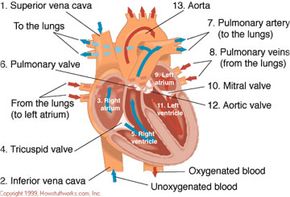Describe How the Blood Flows Through the Heart
If you can visualize the path that blood takes through the heart and know what the heart is doing during diastole and systole many other concepts will be easier for you to understand. Blood Flow Through the Heart.

Blood Circulation In The Fetus And Newborn
The tricuspid valve between the right atrium and right ventricle prevents the backflow of blood.

. The blood flows through the right tricuspid valve into the right ventricle. Question 2 3 3 pts Describe blood flow through the heart starting with blood entering the right side of the heart and including all chambers and valves. Blood goes to the lungs through pulmonary artery.
You can use a flowchart form. 1Describe how blood flows through the heart. Unoxygenated blood enters the right atrium from the superior and inferior vena cavae.
Blood flow through heart right side of the heart. Superior and inferior vena cavae and the coronary sinus 2. The blood circulatory system cardiovascular system delivers nutrients and oxygen to all cells in the body.
Edit Insert Format Tools Table 12ptv Paragraph BIU A 2 Tv р O words. Blood carries oxygen from lungs and nutrients to body tissues. From the right ventricle.
This prevents blood from flowing backward into the atria while the ventricles contract squeeze. Deoxygenated blood from different organs comes to the right atrium through the vena cava. Blood flows from your left atrium into your left ventricle through the open mitral valve.
It consists of the heart and the blood vessels running through the entire body. Blood enters the right atrium from the superior and inferior venae cavae and the coronary sinus. As the heart contracts it pumps blood into your blood vessels which then circulate the blood to the body before it goes back again to the heart.
The diagram below shows the path of the. The left atrium receives oxygenated blood through the pulmonary veins from the lungs. Oxygen-poor blood enters the right atrium through three veins the inferior and superior vena cava and the coronalis sinus and passes through the right ventricle.
The ventricle sends blood through the pulmonic valve into the pulmonary artery. Describe the flow of blood through the heart of human beings. The right atrium receives deoxygenated blood through the superior and inferior vena cavas from the body and pumps it to the right ventricle through the tricuspid valve which opens to allow the blood flow through and closes to prevent blood backing up the atrium.
As the human heart beats it pumps blood through the system of blood vessels known as circulatory system. From the right ventricle it goes through the pulmonary semilunar valves to the pulmonary trunk 4. Path of Blood Through the Heart.
The left side of your heart takes oxygen-rich blood from your lungs and pumps it to the rest of your body through your arteries. From the right atrium blood goes to the right ventricle. Describe the flow of blood through the heart and associated circuits as if you were a red blood cell about to enter the right atrium.
The right atrium is where the blood first enters. The following are the steps of blood flow via the heart. Through the two large venas the lower and the higher vena cava blood enters the heart and draws the oxygen-low blood into the right heart atrium.
From the right ventricle the blood flows through the pulmonic valve into the pulmonary artery. The oxygenated blood is brought back to the heart by the pulmonary veins which. Blood flows from your right atrium into your right ventricle through the open tricuspid valve.
The blood subsequently goes into the right ventricle via the tricuspid valve. The blood flows from your right atrium through the o. From right atrium it goes through the tricuspid valve to the right ventricle.
The blood flows through the tricuspid valve into the right ventricle. The heart has a dual pump function which carries blood away from and. Systemic circulation refers to the bloods movement from your heart throughout the body to supply nutrients and oxygen to the body parts and bringing back the deoxygenated blood to your heart.
The heart is a primarily hollow muscular organ composed of cardiac muscles and connective tissue that works as a pump for the circulation of blood around the tissues of the body. The circulatory system also called the cardiovascular system is responsible for distributing nutrients and oxygen to different parts of the body with the heart working as the pump. Describe the flow of blood through the heart.
Blood rich in oxygen leaves your lungs and enters your left atrium via the pulmonary veins. The arteries carry blood away from the heart. Beginning with the superior and inferior vena cavae and the coronary sinus the flowchart below summarizes the flow of blood through the heart including all arteries veins and valves that are passed along the way.
Unoxygenated blood blood enters the right atrium from the superior and inferior vanae cavae. Pathway of blood through the heart 1. Then the right ventricle pumps the blood through the pulmonary artery to the lungs where it becomes oxygenated.
Anatomy and Physiology questions and answers. From the right ventricle the blood flows through the. It is pumped to your left ventricle via your mitral valve.
The veins carry it back to the heart. When the ventricles are full the tricuspid valve shuts. The trunk the main artery aorta branches into.
These vessels are muscular and elastic to carry blood to all body parts. The system of blood vessels resembles a tree.


Comments
Post a Comment